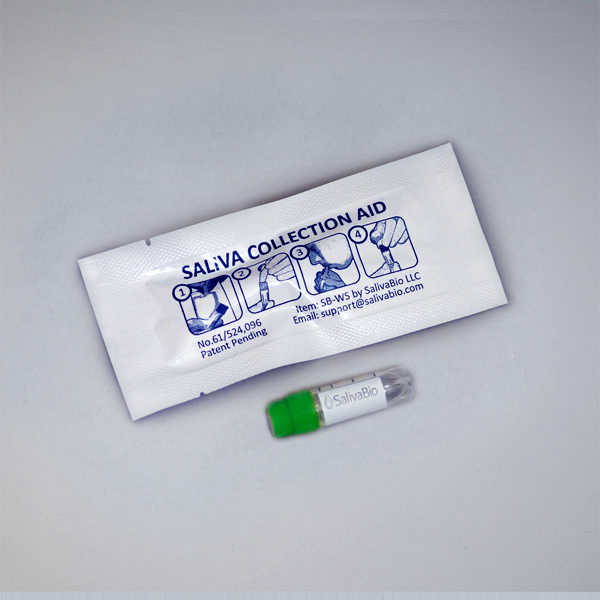Need Help?
Ask an expert
1. How to collect Salivary TNF-Alpha
APPROVED SALIVARY TNF-ALPHA COLLECTION METHODS
Salivary TNF-Alpha Collection Protocol
Collection volume, general considerations, and basic guidelines to maximize salivary TNF-alpha sample integrity. Use this analyte-specific collection protocol to plan you collection methodology and sampling schemes.

2. How to Assay for Salivary TNF-Alpha
Send Saliva Samples to Salimetrics
Add to StudyEasy and accurate results from the most trusted Salivary Bioscience Laboratory.
Order Code5291
3. Technical Summary
| Analyte Summary | |
|---|---|
| Analyte: | Tumor Necrosis Factor Alpha |
| Aliases: | TNF-Alpha, TNF-α, cachectin |
| Serum-Saliva Correlation: | NA |
| *Optimum Collection Volume: | 425 μL |
*Add 300 µl to the total volume of all tests for liquid handling
| Assay Summary | |
|---|---|
| Methodology: | ECL |
| Sensitivity: | 0.106 pg/mL |
| Assay Range: | 0.04 - 1360 pg/mL |
| Assay Type: | Quantitative |
Background
*Also available as part of the Salimetrics Cytokine Panel*
Tumor necrosis factor alpha (TNF-Alpha) is a member of a family of small biologically active proteins known as cytokines. TNF-α plays a key role in the innate inflammatory response in vertebrates. When macrophages and T cells detect an invading pathogen, they produce TNF-α, triggering local production of chemokines and additional cytokines, which then attract and activate leukocytes at the infection site. (1-4) TNF-α also participates in the development of acquired immunity from the infection. (5) TNF-α plays a role in numerous other processes throughout the body, including remodeling of tissues and causing apoptosis of tumor cells. (6) Dysregulation of TNF-α production is involved in periodontal disease, heart disease, auto-immune conditions, and osteoarthritis. (7-11) Messenger RNA for TNF-α has been found in tissues of healthy human labial salivary glands, and the expression levels of the mRNAs were either up-or down-regulated by adjacent focal infiltrating lymphoid cells. (12) The epithelial cells in the salivary glands are active participants in the autoimmune-mediated process of Sjögren’s syndrome, and TNF-α levels are increased in that disease. (12,13) Relationships between TNF-α levels in blood and saliva are not fully understood.References & Salivary TNF-Alpha Research
-
-
- Czermak, B.J., Sarma, V., Bless, N.M., et al. (1999). In vitro and in vivo dependency of chemokine generation on C5a and TNF-α. J Immunol, 162(4), 2321-25.
- Tanabe, K., Matsushima-Nishiwaki, R., Yamaguchi, S., et al. (2010). Mechanisms of tumor necrosis factor-α-induced interleukin-6 synthesis in glioma cells. J Neuroinflammation, 7, 16.
- Sternberg, E.M. (2006). Neural regulation of innate immunity: A coordinated nonspecific host response to pathogens. Nat Rev Immunol, 6(4), 318-28.
- Heller, R.A., Krönke, M. (1994). Tumor necrosis factor receptor-mediated signaling pathways. J Cell Biol, 126(1), 5-9.)
- Mastroeni, P., Ménager, N. (2003). Development of acquired immunity to Salmonella. J Med Microbiol, 52(pt 6), 453-59.
- Goodsell, D.S. (2006). The molecular perspective: Tumor necrosis factor. Oncologist, 11(1), 83-4.
- Giannobile, W.V., Beikler, T., Kinney, J.S., et al. (2009). Saliva as a diagnostic tool for periodontal disease: Current state and future directions. Periodontology 2000, 50, 52-64.
- Torre-Amione, G., Kapadia, S., Lee, J., et al. (1996). Tumor necrosis factor-α and tumor necrosis factor receptors in the failing human heart. Circulation, 93(4), 704-11.
- Kulkarni, K., Selesniemi, K, Brown, T.L. (2006). Interferon-gamma sensitizes the human salivary gland cell line, HSG, to tumor necrosis factor-alpha induced activation of dual apoptotic pathways. Apoptosis, 11(12), 2205-15.
- Wu, A.J., Chen, Z.J., Tsokos, M. et al (1996), Interferon-gamma induced cell death in a cultured human salivary gland cell line. J Cell Physiol, 167(2), 297-304.
-
- Fernandes, J.C., Martel-Pelletier, J., Pelletier, J.P. (2002). The role of cytokines in osteoarthritis pathophysiology. Biorheology, 39(1-2), 237-46.
- Sun, D., Emmert-Buck, M.R., Fox, P.C. (1998). Differential cytokine mRNA expression in human labial minor salivary glands in primary Sjögren’s syndrome. Autoimmunity, 28(3), 125-37.
- Fox, R.I., Kang, H.I, Ando, D., et al. (1994). Cytokine mRNA expression in salivary gland biopsies of Sjögren’s syndrome. J Immunol, 152(11), 5532-39.
-
 Contact: Salimetrics (USA)
Contact: Salimetrics (USA)



